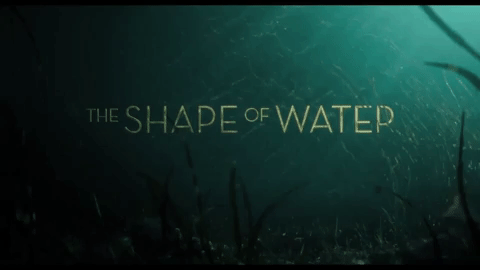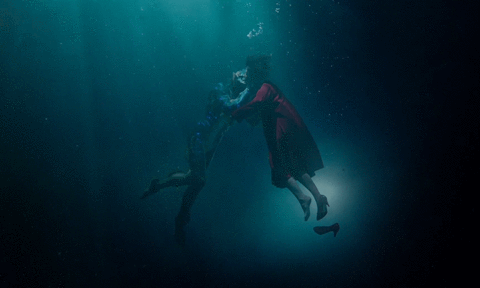
Complimentary together, yet strikingly different. I can’t help but notice the correlations between the use of color in this film and how it reflects upon the relationships and circumstances of all the characters. Primarily the emphasis on the two colors of red and green, colors which are placed on polar opposite ends of a standard color wheel, but are at the same time complementary to one another. Just think of the most popular color scheme of the Christmas season, for example. Much like our two protagonists, the two colors couldn’t be more different, but somehow they still work beautifully when joined side-by-side.
When green makes an appearance on screen it always seems to signal to the false nature of the person, concept, or thing that is presented alongside it. To start, the Pie Guy who has captured Giles’ (Jenkins) attention is entirely fraudulent: his Southern accent is an act, the diner is a franchise and the Key Lime Pie that Giles always orders is even dyed a ridiculous artificial shade of green. None of the pies even seem to taste good, but Giles keeps storing the barely eaten slices in his refrigerator anyway. This act seems to serve as an outward manifestation of Giles’ dedication to the fantasy he’s constructed of his relationship with the Pie Guy; built on nothing more than his extrapolating from the professional niceties exchanged between a server & customer. The pleasantries and attention that Pie Guy has paid to Giles are ultimately revealed to be no more genuine than his accent, however. At the moment when Giles finally expresses that he’d really like to get to know Pie Guy better, his attempts at developing the relationship further are met with disgust and anger. Immediately following this exchange Pie Guy tells an African American couple that just walked into the diner that they cannot sit at the counter and, along with Giles, really ought to leave. The Pie Guy and the pastries he sells are nothing more than saccharine illusions – no genuine kindness, no genuine flavor.
Concurrently happening with his failed attempts at romantic love, Giles is also diligently working on a new illustrated ad for JELL-O where the food is initially instructed to be rendered as red. However, upon bringing that finished product to a man at the ad agency he’s told to change it to green, that’s what the folks in charge want now. Red is out, green is in. And by the way, he needs to make the family look even happier. Ultimately though, his illustrations just can’t live up to the realness captured by a photograph, so his re-worked second attempt is rejected as well. Quite the irony considering an advertisement is artificial by its very nature.
The figures represented in Giles’ ad serve as the epitome of the picturesque 1950s nuclear family. An artificial reality of idealized Americana that Richard Strickland (Shannon) & his family appear to reflect. Made up of a professional working man who embodies all the ideations of masculinity, a housewife who only wants to make him happy, and two children who are perfectly groomed and behaved, they are the target audience for “buying in” to the vision sold by Giles’ ad. We are even shown late in the film that Mrs. Strickland has made a green JELL-O parfait for her family, so clearly that new ad succeeded in its job.
Strickland himself is consumed with & surrounded by green. He constantly pops green candies; he purchases a “green” (teal) Cadillac; his re-attached digits rot away throughout the film by what appears to be gangrene. He is a man for whom appearances matter far more than actual substance, which can be articulated by his refusal to accept the reality of his fingers failing to heal and literally rotting away from infection because he needs to keep up appearances, even though everyone else can clearly see there’s something deeply wrong. He has bought into the “American Dream” with the tie, the wife, the kids, the car and the concept of “decency”, but much like the rest of his life that decency is only just for show (despite what he’s told himself). This self-deception is so deeply embedded that he seems legitimately shocked when his superior, General Hoyt, tells him that this code of “decency” is nothing more than a bill of goods exported by America because we no longer have any use for it here.
Red, on the other hand, signals love, compassion, friendship, and sexuality. Guillermo del Toro has stated that when decisions about colors for the film were made, Elisa’s wardrobe would contain more red as her relationship with The Asset continued to develop and she fell more in love. At the beginning we see Elisa (Hawkins) longingly eyeing a pair of red shoes in a store window, desiring the shoes much like she desires to be in a relationship with another, to have that kind of love for herself. Once she acquires The Asset, she also acquires the red shoes, then a red headband, and a red trenchcoat as their relationship progresses.
Indeed, the two groups of characters in this film could be easily divided between the “green people” and the “red people”. The Greens are all those involved with the intent to hurt & destroy others for their own self-serving needs. The Reds consist of those who hold the welfare of others in higher esteem, concerned with a bigger picture outcome that hurts others as little as possible. I don’t think it’s any coincidence that the scientist Dr. Robert Hoffstetler (Stuhlbarg) who develops an affection for The Asset & helps save him is quite literally “red” by virtue of being a Russian spy. One can’t help but draw the correlations of capitalism (green) and socialism (red) in the ways the different camps of characters view their world and the people, and creatures, who live in it. A character whose life philosophy is shaded by green is more concerned with seeing how others can be most useful to them and do not take into consideration the value held by individuals beyond that usefulness. A red character, meanwhile, recognizes that each living thing has an inherent worth and that none of us exist merely to be exploited by others. This philosophy emphasizes acceptance, love of self in accordance with the love of others, empathy, and compassion.
The theme of opposites and the inverse natures represented in this color scheme is at the heart of the film’s narrative. The romantic relationship that develops between Elisa and The Asset is a joining of two completely different worlds which might appear to oppose one another but which ultimately complement one another effortlessly. Theirs is a relationship built on a deep acceptance of the other, as they are, with no qualifications. When that kind of recognition and acknowledgment occurs between two individuals, appearances play no bigger role other than serving as a nice bonus. This kind of easygoing acceptance extends to the friendships between Elisa, Giles, and Zelda (Spencer). Elisa is a mute LatinX woman, Zelda is black, and Giles is gay. Despite being very different from one another on the surface, they are all outsiders themselves in some way. This rejection by the world has given them an innate understanding of and solidarity with not only one another but with The Asset who is also not found acceptable by societal standards. Whereas Strickland and his ilk are coded as the ideal, it is actually the group who do not look the part who end up being the most “decent” of all.
Echoing this unification of different “tribes” (if you will) is the theater that Elisa and Giles live above playing the 1960 film The Story of Ruth, which details the Biblical tale of Ruth who made the decision to leave behind her own people and join the Israelites. I’m not the type of Christian who tries to extrapolate Biblical themes out of every form of media I partake, but this link between Ruth’s story and Elisa’s is pretty conspicuous: two women, orphaned and alone, immerse themselves in a world wholly different from the one they came from, leaving their old lives completely behind them for a whole new reality. Additionally, Elisa’s story of being found as an infant floating in a river and taken in by the orphanage, then freeing a captured and enslaved creature, have very clear ties to the story of Moses.
Finally, I would just like to give a brief acknowledgment of the total normalcy with which female sexuality was portrayed by del Toro and just how much I loved and appreciated this. Within the first five minutes of the film, we see Elisa go through her daily routine of getting ready for work, which just happens to involve her masturbating in her tub. It’s not excessively graphic, prolonged, or scintillating, it just simply IS. Later on, Strickland’s wife is the one who initiates sex with him and who establishes the rule of what has to happen before they can begin. In fact, all sexual encounters and experiences that occur within the movie are initiated by women clearly giving enthusiastic consent. Women are capable of existing as sexual beings utterly unto themselves and not just for the service and pleasure of others. Outside of identifying as asexual, women do indeed desire physical intimacy and pleasure. This is just an ordinary part of life for many, yet seeing this portrayed as natural in any form of visual media is so incredibly rare that it’s made to appear as though it’s abnormal. The void of normalized female sexuality that permits women their agency within mainstream film & television is quite glaring, so I’m giving all the kudos and applause to Mr. del Toro for portraying female desire as an acceptable reality.
The Shape of Water is such an exquisite and delightful picture, visually and thematically. I cannot laud and praise it enough, so if you haven’t watched it already I would advise you do so as soon as possible. Finding ourselves living in the sort of reality that we currently do, it’s a soul-renewing experience to see love and goodness win the day once in awhile.





